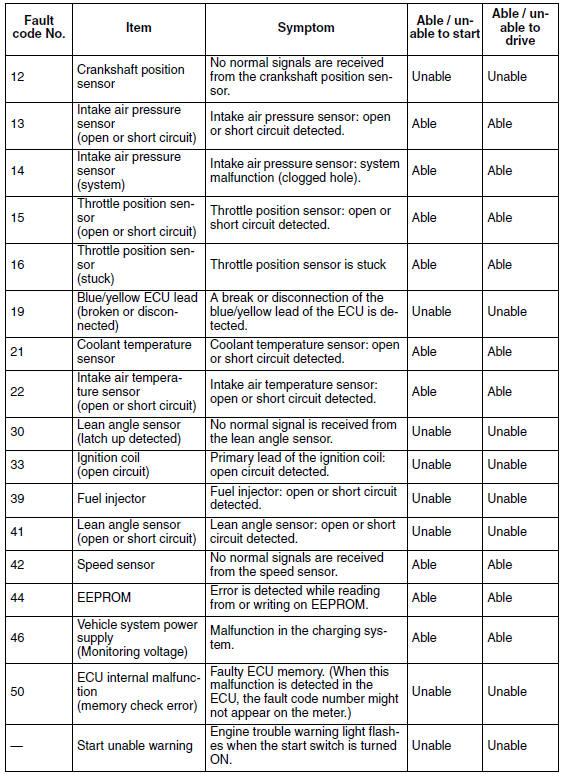Yamaha YZF-R125 Service Manual: Self-diagnostic function table
If the ECU detects an abnormal signal from a sensor while the vehicle is being driven, the ECU illuminates the engine trouble warning light and provides the engine with alternate operating instructions that are appropriate for the type of malfunction.
When an abnormal signal is received from a sensor, the ECU processes the specified values that are programmed for each sensor in order to provide the engine with alternate operating instructions that enable the engine to continue to operate or stop operating, depending on the conditions.
Self-Diagnostic Function table

 Ecu self-diagnostic function
Ecu self-diagnostic function
The ECU is equipped with a self-diagnostic function in order to ensure that
the fuel injection system is
operating normally. If this function detects a malfunction in the system, it
immediately o ...
 Troubleshooting method
Troubleshooting method
The engine operation is not normal and the
engine trouble warning light comes on.
1. Check:
Fault code number
a. Check the fault code number displayed on
the FI diagnostic tool.
b. Identi ...
Other materials:
Adjusting the throttle cable free play
NOTE:
Prior to adjusting the throttle cable free play, the
engine idling speed should be adjusted.
1. Check:
Throttle cable free play "a"
Out of specification →Adjust.
2. Remove:
Right side panel
Refer to "GENERAL CHASSIS" on page 4-1.
3. Adjust:
Throttle cable f ...
Removing the generator
1. Remove:
Generator rotor nut "1"
Washer
NOTE:
While holding the generator rotor "2" with the
sheave holder "3", loosen the generator rotor
nut.
Do not allow the sheave holder to touch the
projection on the generator rotor.
2. Remove:
Generator rotor "1"
(with the ...
Important manual information
Particularly important information is distinguished in this manual by the
following notations:
This is the safety alert symbol. It is used to alert you to potential personal
injury
hazards. Obey all safety messages that follow this symbol to avoid possible
injury
or death.
WARNING
...
